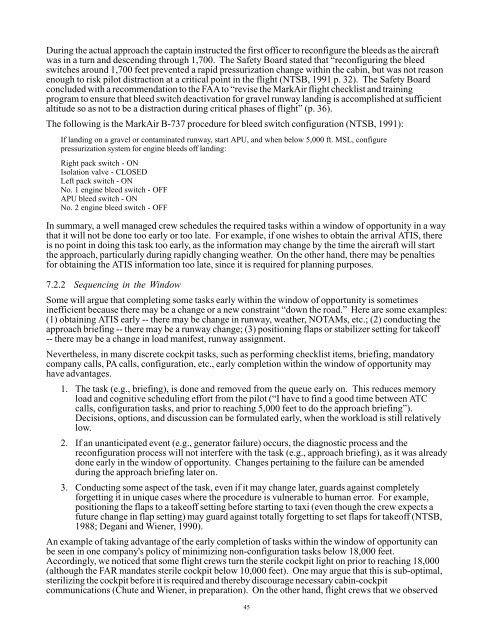On the Design of Flight-Deck Procedures - Intelligent Systems ...
On the Design of Flight-Deck Procedures - Intelligent Systems ...
On the Design of Flight-Deck Procedures - Intelligent Systems ...
You also want an ePaper? Increase the reach of your titles
YUMPU automatically turns print PDFs into web optimized ePapers that Google loves.
During <strong>the</strong> actual approach <strong>the</strong> captain instructed <strong>the</strong> first <strong>of</strong>ficer to reconfigure <strong>the</strong> bleeds as <strong>the</strong> aircraftwas in a turn and descending through 1,700. The Safety Board stated that “reconfiguring <strong>the</strong> bleedswitches around 1,700 feet prevented a rapid pressurization change within <strong>the</strong> cabin, but was not reasonenough to risk pilot distraction at a critical point in <strong>the</strong> flight (NTSB, 1991 p. 32). The Safety Boardconcluded with a recommendation to <strong>the</strong> FAA to “revise <strong>the</strong> MarkAir flight checklist and trainingprogram to ensure that bleed switch deactivation for gravel runway landing is accomplished at sufficientaltitude so as not to be a distraction during critical phases <strong>of</strong> flight” (p. 36).The following is <strong>the</strong> MarkAir B-737 procedure for bleed switch configuration (NTSB, 1991):If landing on a gravel or contaminated runway, start APU, and when below 5,000 ft. MSL, configurepressurization system for engine bleeds <strong>of</strong>f landing:Right pack switch - ONIsolation valve - CLOSEDLeft pack switch - ONNo. 1 engine bleed switch - OFFAPU bleed switch - ONNo. 2 engine bleed switch - OFFIn summary, a well managed crew schedules <strong>the</strong> required tasks within a window <strong>of</strong> opportunity in a waythat it will not be done too early or too late. For example, if one wishes to obtain <strong>the</strong> arrival ATIS, <strong>the</strong>reis no point in doing this task too early, as <strong>the</strong> information may change by <strong>the</strong> time <strong>the</strong> aircraft will start<strong>the</strong> approach, particularly during rapidly changing wea<strong>the</strong>r. <strong>On</strong> <strong>the</strong> o<strong>the</strong>r hand, <strong>the</strong>re may be penaltiesfor obtaining <strong>the</strong> ATIS information too late, since it is required for planning purposes.7.2.2 Sequencing in <strong>the</strong> WindowSome will argue that completing some tasks early within <strong>the</strong> window <strong>of</strong> opportunity is sometimesinefficient because <strong>the</strong>re may be a change or a new constraint “down <strong>the</strong> road.” Here are some examples:(1) obtaining ATIS early -- <strong>the</strong>re may be change in runway, wea<strong>the</strong>r, NOTAMs, etc.; (2) conducting <strong>the</strong>approach briefing -- <strong>the</strong>re may be a runway change; (3) positioning flaps or stabilizer setting for take<strong>of</strong>f-- <strong>the</strong>re may be a change in load manifest, runway assignment.Never<strong>the</strong>less, in many discrete cockpit tasks, such as performing checklist items, briefing, mandatorycompany calls, PA calls, configuration, etc., early completion within <strong>the</strong> window <strong>of</strong> opportunity mayhave advantages.1. The task (e.g., briefing), is done and removed from <strong>the</strong> queue early on. This reduces memoryload and cognitive scheduling effort from <strong>the</strong> pilot (“I have to find a good time between ATCcalls, configuration tasks, and prior to reaching 5,000 feet to do <strong>the</strong> approach briefing”).Decisions, options, and discussion can be formulated early, when <strong>the</strong> workload is still relativelylow.2. If an unanticipated event (e.g., generator failure) occurs, <strong>the</strong> diagnostic process and <strong>the</strong>reconfiguration process will not interfere with <strong>the</strong> task (e.g., approach briefing), as it was alreadydone early in <strong>the</strong> window <strong>of</strong> opportunity. Changes pertaining to <strong>the</strong> failure can be amendedduring <strong>the</strong> approach briefing later on.3. Conducting some aspect <strong>of</strong> <strong>the</strong> task, even if it may change later, guards against completelyforgetting it in unique cases where <strong>the</strong> procedure is vulnerable to human error. For example,positioning <strong>the</strong> flaps to a take<strong>of</strong>f setting before starting to taxi (even though <strong>the</strong> crew expects afuture change in flap setting) may guard against totally forgetting to set flaps for take<strong>of</strong>f (NTSB,1988; Degani and Wiener, 1990).An example <strong>of</strong> taking advantage <strong>of</strong> <strong>the</strong> early completion <strong>of</strong> tasks within <strong>the</strong> window <strong>of</strong> opportunity canbe seen in one company's policy <strong>of</strong> minimizing non-configuration tasks below 18,000 feet.Accordingly, we noticed that some flight crews turn <strong>the</strong> sterile cockpit light on prior to reaching 18,000(although <strong>the</strong> FAR mandates sterile cockpit below 10,000 feet). <strong>On</strong>e may argue that this is sub-optimal,sterilizing <strong>the</strong> cockpit before it is required and <strong>the</strong>reby discourage necessary cabin-cockpitcommunications (Chute and Wiener, in preparation). <strong>On</strong> <strong>the</strong> o<strong>the</strong>r hand, flight crews that we observed45
















